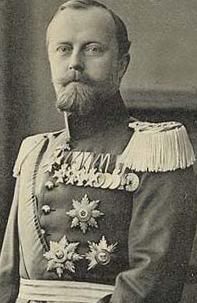Leopold IV, Prince of Lippe
From Kaiserreich

|
Leopold IV von Lippe (born Leopold Julius Bernhard Adalbert Otto Karl Gusta on May, 30 1871 in Oberkassel, Germany), is the sixth and current ruler of Principality of Lippe, one of the constituent states of the German Empire, officially succedding to Prince Alexander on October, 25 1905, being Regent of the country since September, 26 1904.
Biography
Leopold was born as Count Leopold of Lippe-Biesterfeld, son of Count Ernst of Lippe-Biesterfeld and Countess Karoline of Wartensleben. Leopold belonged to the Lippe-Biesterfeld line of the House of Lippe which was the most senior line of the princely house after the reigning Lippe-Detmold line. He served as an officer in the German Army until 1894, when he left to study political science at the universities of Bonn and Berlin.
Since 1895 Lippe had been ruled by a regent due to the mental incapacity of Prince Alexander. Leopold's father had acted as regent since 1897 and following his death on September, 26 1904 Leopold assumed the regency. This was not recognised by the German Emperor Wilhelm II who initially refused to legally recognise Leopold as regent as there was an issue over whether Leopold and his siblings were of legitimate rank and as such eligible for the succession. As a result the Diet of Lippe appointed a high commission to consider the matter.
The regency issue was still ongoing when Prince Alexander died on January, 13 1905. Leopold was confirmed as Prince of Lippe and Alexander's successor on October, 25 1905 following a court ruling. On 3 June 1911 while out motoring Leopold and his brother Prince Julius were attacked by a gang of Italian labours who hurled a shower of missiles at the princes. Though Leopold escaped unhurt his brother received a head wound.
During the Weltkrieg Leopold upgraded the titles of the various lines of the House of Lippe. One of the members to benefit from the granting of titles was Leopold's nephew Count Bernhard of Lippe-Biesterfeld who would go on to become the Prince Consort of Queen Juliana of the Netherlands. On 24 February 1916 Bernhard and his brother were upgraded to the title Prince of Lippe-Biesterfeld with the style Serene Highness. The counts of Lippe-Weissenfeld also benefited with creations of the title Prince of Lippe-Weissenfeld with the style serene highness taking place on 24 February 1916 for Count Clemens and his descendants and again on 9 November 1918 for the other members of this line.
Prince Leopold IV was very worried by the fact that the three sons he had from his first wedding, including Hereditary Prince Ernst, have all joined the Pan-Germanist GDVP, a party that, like most of the German old nobility, the Prince considers as nocive and revolutionnary. In an interview in late 1935, the ruling Prince confirmed that he had considered to disinherit his three sons due to their GDVP membership, and give the title of Hereditary Prince to the child he had from his second marriage, Armin. For this, Prince Leopold IV was praised by the leaders of anti-National-Populist movement, even the Republican elements, and was death threatened by some extremist GDVP politicians.
Marriage
Leopold was married to Princess Bertha of Hesse-Philippsthal-Barchfeld (1874-1919) on 16 August 1901 in Rotenburg. They had five children before his wife's death on 1919
- Ernst, Hereditary Prince of Lippe (born 1902)
- Prince Leopold Bernhard of Lippe (born 1904)
- Princess Karoline of Lippe (born 1905)
- Prince Chlodwig of Lippe (born 1909)
- Princess Sieglinde of Lippe (born 1915)
Leopold was married secondly to Princess Anna of Ysenburg-Büdingen (born 1886) on 26 April 1922 at Büdingen. From this marriage he had one son.
- Prince Armin of Lippe (born 1924)
